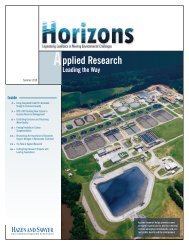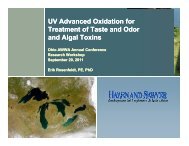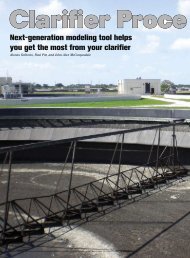Download Horizons Winter 2007 Issue - Hazen and Sawyer
Download Horizons Winter 2007 Issue - Hazen and Sawyer
Download Horizons Winter 2007 Issue - Hazen and Sawyer
Create successful ePaper yourself
Turn your PDF publications into a flip-book with our unique Google optimized e-Paper software.
“Partnership Making Progress” Continued from Page 4<br />
Considering this, the Group determined that reducing<br />
discharges from these treatment plants was essential to<br />
improving water quality in the Sound.<br />
In 1998, after over a decade of research <strong>and</strong> the development<br />
of a water quality model that correlates levels of<br />
nitrogen removal with their impact on dissolved oxygen<br />
<strong>and</strong> water quality, the LISS m<strong>and</strong>ated a 58.5 percent<br />
reduction, from peak levels, of nitrogen discharges. This<br />
multi-phase, bi-state plan, to be implemented over 15<br />
years, was approved by the Environmental Protection<br />
Agency in 2001.<br />
New York Chooses Biological Nutrient Removal<br />
The New York City Department of Environmental<br />
Protection (NYCDEP), the agency responsible for operating<br />
New York City’s 14 Water Pollution Control Plants,<br />
studied multiple nitrogen<br />
removal pathways, including<br />
chemical treatment, biological<br />
treatment, <strong>and</strong> fixed<br />
media before choosing<br />
Biological Nutrient Removal<br />
(BNR) as the most effective<br />
<strong>and</strong> proven large-scale technology.<br />
Plants slated for<br />
BNR upgrades range in size<br />
from 80 to 275 mgd, <strong>and</strong> the<br />
total capital construction<br />
cost for this set of plant<br />
upgrades is expected to exceed $640 million.<br />
Local regulatory agencies applied their own policies<br />
<strong>and</strong> st<strong>and</strong>ards according to the circumstances of their<br />
treatment plants. The New York State Department of<br />
Environmental Conservation adopted an interim “no net<br />
increase” policy for the Sound, <strong>and</strong> implemented a “nitrogen<br />
cap” through modification of permits for the<br />
Westchester County plants.<br />
Additionally, the New Engl<strong>and</strong> Interstate Water<br />
Pollution Control Commission established the Connecticut<br />
River Nitrogen Project Workgroup — recognizing that<br />
some nitrogen in the river (whose outlet is the Long Isl<strong>and</strong><br />
Sound) originates in states north of Connecticut.<br />
Once future limits on nitrogen discharges were<br />
established, the daunting task of designing <strong>and</strong> implementing<br />
upgrades to treatment plants began. Since the<br />
1990s, <strong>Hazen</strong> <strong>and</strong> <strong>Sawyer</strong> has provided comprehensive<br />
program management to the NYCDEP overseeing the<br />
construction of BNR upgrades at five major wastewater<br />
plants. And we’ve also designed <strong>and</strong> provided construction<br />
management services for several BNR upgrades in<br />
New York <strong>and</strong> Connecticut to improve water quality in<br />
the Long Isl<strong>and</strong> Sound.<br />
As BNR upgrades in New York City moved from<br />
the conceptual to the design phase, the Advanced<br />
Wastewater Treatment program (AWT) led by <strong>Hazen</strong><br />
<strong>and</strong> <strong>Sawyer</strong> (as part of a joint venture) issued design<br />
guidance to engineers tasked with plant-specific designs.<br />
This ensured a uniform st<strong>and</strong>ard across the plants <strong>and</strong><br />
sufficient process infrastructure to meet the stringent, new<br />
discharge st<strong>and</strong>ards.<br />
The AWT team considered potential impacts of BNR<br />
on the NYCDEPs other programs, including water conservation,<br />
combined sewer overflow control, <strong>and</strong> floatables<br />
reduction.<br />
During construction of<br />
several New York City BNR<br />
upgrades, modeling played<br />
a key role. The BioWin<br />
process model was used to<br />
calculate the impacts of various<br />
construction-related<br />
changes on plant operations<br />
to ensure that overall nutrient<br />
levels would not climb<br />
too high during the upgrade<br />
process — saving the client<br />
more than half a billion dollars<br />
in unnecessary <strong>and</strong> redundant construction.<br />
Nutrient Reduction Efforts are Helping the Sound<br />
Progress is being made <strong>and</strong> overall water quality is<br />
improving, according to the 2006 Sound Health report<br />
issued by LISS.<br />
Since the early 1990s, there has been a 20 percent<br />
reduction in end-of-pipe discharges of nitrogen from<br />
sewage treatment plants into the Long Isl<strong>and</strong> Sound.<br />
Compared to 1994, this translates into 47,000 fewer<br />
pounds of nitrogen entering the Sound each day.<br />
Though the challenges of implementation are ongoing,<br />
the commitment of local <strong>and</strong> federal regulatory agencies,<br />
coupled with the nitrogen reduction plans of plant owners<br />
<strong>and</strong> their engineers, is making a difference. By reducing<br />
nitrogen levels through good planning <strong>and</strong> new technology,<br />
we hope to protect the ecological value of Long Isl<strong>and</strong><br />
Sound <strong>and</strong> ensure a safe place for recreation, fishing, <strong>and</strong><br />
tourism for many years to come. <br />
6








